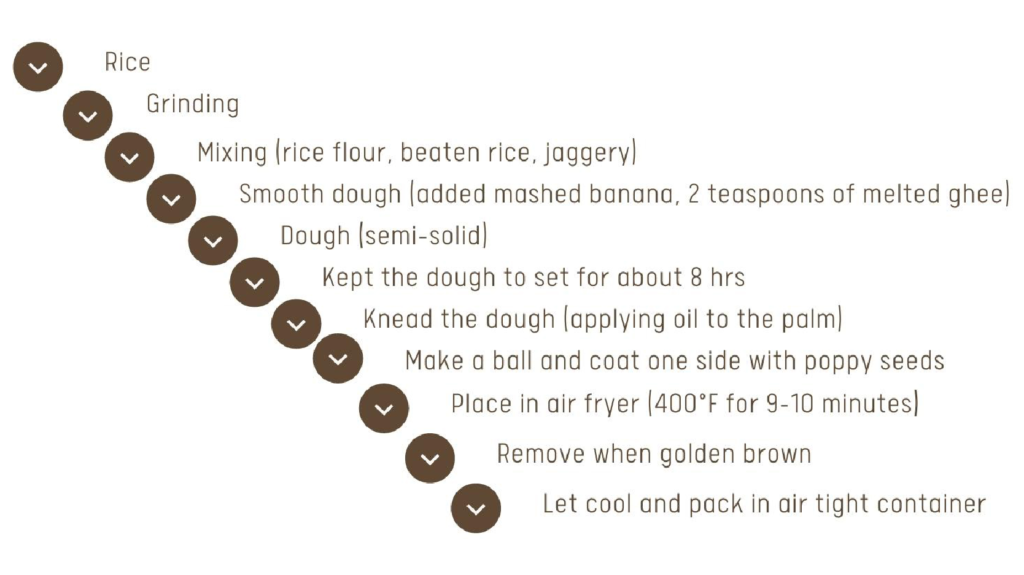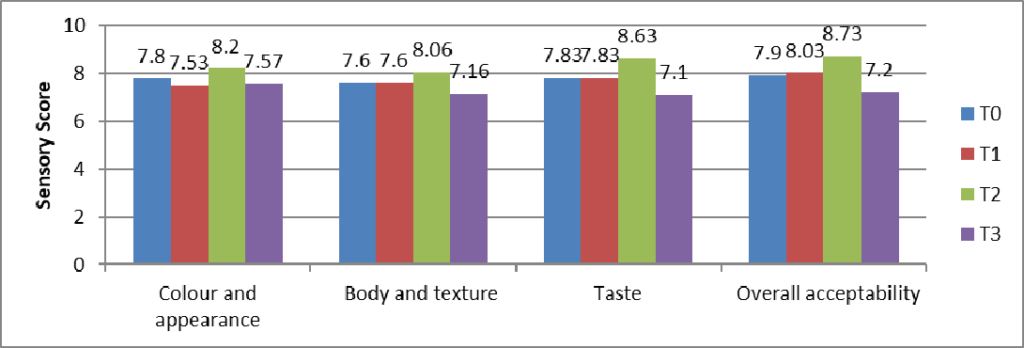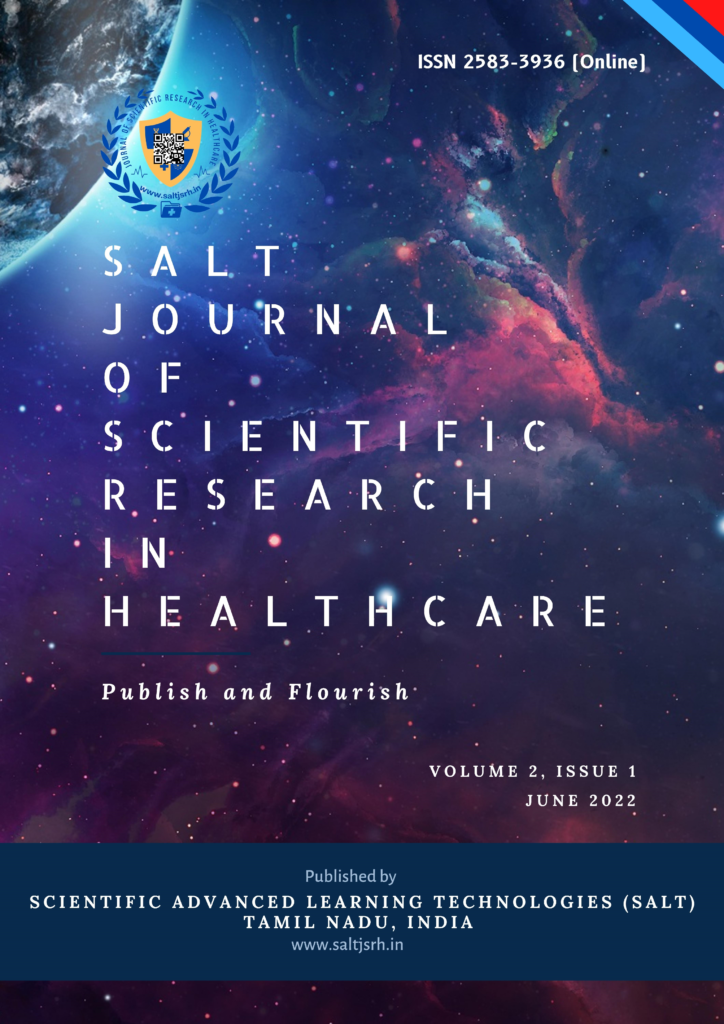DEVELOPMENT AND QUALITY EVALUATION OF A MICRONUTRIENT RICH TRADITIONAL INDIAN PRODUCT BY UTILIZATION OF LOCALLY AVAILABLE FOOD RESOURCES
SALT Journal of Scientific Research in Healthcare
Volume 2, Issue 1, Page 11-16, Published on 14th January 2022
https://doi.org/10.56735/saltjsrh.ms2202011116
Research Article
KOMAL OJHA AND VISHAKHA SINGH
Department of Food Science and Nutrition,
College of Community & Applied Sciences, MPUAT, Udaipur, Rajasthan, India
*Corresponding Author: Dr. Vishakha Singh, Associate Professor, Department of Food Science and Nutrition, College of Community & Applied Sciences, MPUAT, Udaipur, Rajasthan, India.
ORCID ID: 0000-0002-0376-9312
Email: [email protected]
ABSTRACT
Malnutrition is a severe matter of concern among various countries due to modern lifestyles, especially the consumption of rapidly processed fast food. In 2018, a WHO and UNICEF study concluded that the SDG objective of eradicating all forms of malnutrition by 2030 was aspirational but unattainable and set targets for malnutrition indicators up to 2030 based on current trends. The present situation demands products rich in micronutrients, meet growth and development requirements, and are readily acceptable. A critical reason for such use of rice flour is its nonallergenic nature. A small proportion of the population is allergic to wheat gluten. Rice is widely used in baking for such wheat-intolerant people, i.e., those suffering from the coeliac disorder. Its nonallergenic property also makes rice one of the first cereals to be used in infant feeding. In this scenario, rice flour is preferred as the foremost choice for required sensory acceptability and a low-cost diet. Food-based approaches are recognised as an essential part of an urgently needed, more comprehensive strategy for improving nutrition by increasing the availability and consumption to combat calcium, iron, phosphorus and other micronutrient deficiencies. The combination of rice flour, beaten rice, banana, jaggery contains a high amount of energy protein with calcium and iron content. Such a combination of foods can enhance the nutritive value of homemade products, which can be beneficial for the malnourished population. The present study was undertaken to develop anarsa by combining banana, jaggery and rice flour using the air frying method. The developed product was evaluated for sensory attributes by a panel of 10 judges on 9 points hedonic rating scale. The calculated nutritive value from Indian Food Composition Tables (2017) showed that the product (100g) was not only had a high level of macronutrients, i.e. energy (3123.6 Kcal), carbohydrate (172.5g), protein (12.24g), fat (4.52g) but also rich in micronutrients like calcium (262.8mg), phosphorus (294.4mg) and iron (6.52mg). The product was packed and stored for 15 days at ambient temperature in an airtight container. At pre-evaluation, all the sensory parameters at the 9-point hedonic rating scale were found to be highly acceptable between ‘liked moderately’ (rating 8) to ‘liked very much. After 15 days of storage, all sensory parameters changed and were lying in-between ‘liked slightly’ (rating 6) to ‘liked moderately’ (rating 7). The changes in sensory parameters may be due to the darkening of jaggery and changes in the flavour of the product. Thus, it can be concluded that the development and consumption of novel foods from rice flour in combination with other foods like may banana, jaggery and poppy seeds may provide cost-effective and acceptable options for combating macro and micronutrient deficiencies.
Keywords: Rice flour, jaggery, banana, energy dense, mineral profile, sensory evaluation, malnutrition
INTRODUCTION
In the past few years, the intake of fast foods has resulted in fewer intakes of dietary fiber and micronutrients. A sedentary lifestyle has worked as a catalyst in this. Food fortification and awareness of micronutrient-rich local food resources are necessary to overcome this problem. In this context, enrichment of rice flour can be done with locally available foods like fruits and vegetables as they contain large amounts of most of the micronutrients. Rice is also one of the foods which are considered to be a potential food vehicle for the fortification of micronutrients because of its regular consumption. Many studies tried to add iron and zinc in rice to reduce the nutritional problems, especially micronutrient deficiencies. A study in Bangladeshi children and their caregivers showed that rice was the main source of zinc intake, providing 49% of dietary zinc to children and 69% to women (Arsenault et al. 2010). Rice flour is still taken as food for poor and traditional consumers. Little work has been done on developing rice flour-based ready-to-use or ready-to-eat convenience food products, and also limited efforts have been made to diversify its food uses by application of traditional and contemporary food-processing methods. Cereals like wheat and rice staple food but the use of rice as a substitute for wheat in the diets of wheat-intolerant patients has long been recognised (Dicke et al. 1953). Sensitivity to wheat in coeliac disorder is considered to be due to the gliadin protein in wheat (Kasarda et al. 1978). There might be other minor factors as well for this sensitivity. Rice, being the least allergenic of all cereals, is widely used to meet the food requirement of people so affected. This is why rice is frequently advised as the first cereal for infants, and rice flour is frequently used in baking. Jaggery is a significant part of the Indian diet since it is consumed directly or used to make a variety of sweet-based dishes (Verma and Narain, 1990). Because of its use in Ayurveda and its resemblance to honey, jaggery has commonly referred to as “medicinal sugar” (The Agriculture and Processed Food Products Export Development, APEDA, 2016). The granular jaggery is rich in minerals (0.6-1%) as it contains 9mg% calcium, four mg% phosphorus and 12mg% iron (Singh et al. 1978). Tidke et al. (2017) used jaggery for the development of peanut and chickpea nut chikki and found the chikki organoleptically acceptable. Banana fruits are composed of soft, easily digestible flesh made up of simple sugars like fructose and sucrose that instantly replenish energy and revitalise the body upon consumption. The fruits hold a good amount of soluble dietary fiber that helps normal bowel movements by reducing constipation problems. They are an excellent source of carbohydrates and provide calories and other nutrients. In India, a majority belongs to the poor strata, and their diet mainly consists of cereals. Air frying cooking is an important processing technique. Many studies showed that excessive consumption of fried products could lead to serious health risks such as cardiovascular disease, hypertension, diabetes, cancer and obesity. These facts, combined with society’s current trend toward fat-free products, have forced the industry, in general, and the chips industry in particular, to focus their efforts on developing alternative frying methods that result in products with low oil content but the same flavour, colour, and texture that consumers prize. Many strategies have been proposed to reduce the oil content in fried products, such as low pressure or microwave application or different pretreatments such as blanching, freezing or pre-drying (Moreira et al. 1997). Hot air frying is a new technique to get fried products through direct contact between an external emulsion of oil droplets in hot air and the product into a chamber. The product is constantly in motion to encourage uniform contact between the two phases. The product is dehydrated in this manner, and the distinctive crust of fried foods gradually forms. As a result, the amount of oil required is substantially less than deep oil frying, resulting in very low-fat items. In food processing, it is being used increasingly to modernise traditional recipes. It modifies the nutritive value of products qualitatively as well as quantitatively. Rice flour is always cheaper. The present work deals with enriching a rice flour-based traditional recipe with banana to enhance its mineral profile and energy density. An effort was made to produce the traditional Indian snack, “Anarsa”, which is also known as “Athirasam”. Anarsa is called as Athirasam, Ariselu, Kajjaya, etc. Traditionally anarsa is made from soaked rice and jaggery. The rice is soaked in water for almost three days, but water is changed daily to mitigate fermentation. The rice is then dried and ground into an excellent powder and is mixed with jaggery. However, in today’s busy life schedule, it is not easy to follow this traditional recipe. These Banana Anarasas are equally porous, crunchy, light, and flavorful like our traditional anarsas.
OBJECTIVES
1. To develop and evaluate the sensory and nutritional quality of rice flour and banana-based anarsa.
2. To study the shelf life of developed anarsa.
MATERIALS AND METHODS
Methodology: The materials used and method adopted in the experiments conducted for the attainment of objectives has been elaborated under the following sections:
Selection of recipes: Keeping in view the nutritional benefits of rice flour, banana and jaggery for the malnourished population, they were selected to develop micronutrient-rich traditional product anarsa.
1. Standardization of recipe
a. Planning of recipe: The recipe was selected, i.e. anarsa, and it was standardised.
b. Procurement and preparation: All the raw ingredients were procured from the local market of Udaipur. The recipe was prepared in the Foods lab of the Department of Food Science and Nutrition, College of Community and Applied Sciences, MPUAT, Udaipur, Rajasthan. The recipe was prepared mainly using rice flour, banana and jaggery.
c. Preparation of sample:: Grind rice flour, beaten rice, cardamom and jaggery together in a mixer to get a fine powder. To make a smooth and soft dough mashed banana and two teaspoons of melted ghee were added. A smooth dough was prepared, covered, and kept to set for about 8 hours. Knead the dough very gently by applying oil to the palms. Pinch a small amount of dough and make a ball, and coat one side with poppy seeds. Then flatten it into small thin discs on the greased palm gently by using fingertips. Place anarsa on air fryer parchment sheet liners (or a piece of parchment paper cut to fit your air fryer) about 1 inch apart. Air fry at 400 degrees Fahrenheit for 9 – 10 minutes till golden on top.
d. Blended flour preparation: Blends were prepared by mixing banana with rice flour in different ratios. Different treatments with the names T1, T2, and T3, were prepared with the standard T0, as shown in Table 1.

e. Development of product (Anarsa): Preparation time: 25-30 minutes, Baking time: 10 minutes, Pieces: 10
f. Product development and sensory evaluation: One sample served as control, designated as standard (T0), and other test recipes, i.e. T1, T2, T3, were made by incorporation of banana with rice flour in different proportions of 30%, 30%, and 40%, respectively. All the sensory parameters were tested at a 9-point hedonic scale (Ranganna, 1986). A semi-trained panel did the evaluation. The panellists were asked to record the level of liking or disliking by giving marks for various characteristics of the products as taste, flavour, texture, colour and appearance and overall acceptability. The sample was rated on 9 points hedonic rating scale for quality attributes according to grade description and scoring.
RESULTS AND DISCUSSION
The developed recipe (anarsa) was analysed for organoleptic acceptability. The result has been presented in Figure 2. The mean scores of overall acceptability indicate that T2 (8.73) had the highest score, followed by T1 (8.03), T3 (7.2) and T0 (7.9), respectively. The scoring shows that the treatment T2 was ‘liked very much’ while T1, T3 and T0 were ‘moderately liked’ by the panel of judges. At pre-evaluation, all the sensory parameters were found to be highly acceptable between ‘like very much’ (rating 8) to ‘like moderately’ on 9 points Hedonic rating scale.
The nutritional value of banana incorporated anarsa flour was calculated using the Indian Food Composition Tables, 2017 and is presented in Table 2. It is evident from the results that the recipe has a higher level and amount of energy (3123.6 kcal), carbohydrate (172.5), protein (12.24g %), fat (4.52g %), iron (6.52mg %), calcium (262.8mg %) and phosphorus (294.4mg %).
The anarsas were packed in an airtight container on zero-day and stored at ambient temperature in a cool and dark place for 15 days. On the 15th day of storage, the anarsas were subjected again to sensory evaluation by the same panel of judges. The results revealed that all sensory parameters changed in-between ‘liked slightly’ (rating 6.5) to ‘liked moderately’ (rating 7) on 9 points hedonic rating scale (Table 3).
After 15 days of storage, the product changed a lot; they became more darkened in colour, hard in texture, and changed in flavour, aroma, and taste. If any discolouration, darkened in colour (black), or mould developments are noticed, it clearly shows that the product has gone wrong, and it is advised not to consume it (Eatdelights.com, 2021). The changes in sensory parameters maybe because of darkening and changes in the flavour of banana anarsas.
CONCLUSION
Thus, on the basis of the above results, the oil uptake was lower under air-frying, confirming that this technique can be considered a healthy one. It can be concluded that the banana anarsa is a nutritious product after the incorporation of banana, rice flour, beaten rice and jaggery. It contains a high amount of macronutrients, i.e. energy, carbohydrate, protein and reasonable amounts of micronutrients such as iron, phosphorus and calcium. The banana and rice flour anarsas can be used to feed malnourished children and adults.





REFERENCES
- Agriculture and Processed Food Products Export Development, APEDA, 2016.
- Arsenault JE, Yakes EA, Hossain MB, Islam MM, Ahmed T, Hotz C, Lewis B, Rahman AS, Jamil KM, Brown KH. The current high prevalence of dietary zinc inadequacy among children and women in rural Bangladesh could be substantially ameliorated by zinc biofortification of rice. J Nutr. 2010 Sep;140(9):1683-90. https://doi.org/10.3945/jn.110.123059. Epub 2010 Jul 28. PMID: 20668253.
- Dicke WK, Dicke HA, Weijers JH, Van De Kamer. Celiac disease. II. II. The presence in wheat of a factor having a deleterious effect in cases of coeliac disease. Acta Paediatr (Stockh). 1953 Jan;42(1):34-42. https://doi.org/10.1111/j.1651-2227.1953.tb05563.x. PMID: 13050382.
- Food and Agriculture Organization (FAO). Nutritional contribution of rice and impact of biotechnology and biodiversity in rice-consuming countries. 2001.
- FAO, International Fund for Agricultural Development, UNICEF, WHO. The state of food security and nutrition in the world 2018.Building climate resilience for food security and nutrition. Food and Agriculture Organization of the United Nations, Rome 2018.
- Kasarda DD. The relationship of wheat proteins to celiac disease. Cereal Foods World. 1978; 23: 240–244.
- Longvah T, Ananthan R, Bhaskarachary K, Venkaiah K. Indian Food Composition Tables. National Institute of Nutrition. Indian Council of Medical Research Hyderabad. 2017.
- Moreira RG, Sun X, Chen Y. Factors affecting oil uptake in tortilla chips in deep – fat frying. Journal of Food Engineering. 1997; 31:485-98.
- Ranganna S. Handbook of Analysis and Quality Control for Fruit and Vegetable Products. Tata Mc Graw Hill Publishing Company Ltd. New Delhi. 1986.
- Singh M, Bharadwaj KM, Agrawal ML. Storage of jaggery. Cooperative Sugar. 1978; 3:14-17.
- Tidke B, Sharma HK, Kumar N. Development of peanut and chickpea nut brittle (chikki) from incorporation of sugar, jaggery and corn syrup. International Food Research Journal. 2017; 24: 657-663.
- Verma VK, Narain M. Moisture absorption isotherms of jaggery. Journal of Stored Products Research. 1990; 26: 6146-6147.
ARTICLE TYPE: Research Article;
ORCID ID: Open Researcher and Contributor Identifier (ORCID) ID of corresponding author: https://orcid.org/0000-0002-0376-9312;
ETHICAL: NA;
ACKNOWLEDGEMENT: None;
FINANCIAL DISCLOSURE: The authors declare that there was no financial aid received.;
CONFLICT OF INTEREST: No conflict of interest associated with this research work.;
AUTHORS CONTRIBUTION: K.O., performed the experiments and wrote the paper, V.S., designed research and supervised the findings of the work.; CORRESPONDING AUTHOR AFFILIATIONS: Dr Vishakha Singh, Associate Professor, Department of Food Science and Nutrition, College of Community & Applied Sciences, Maharana Pratap University of Agriculture and Technology (MPUAT), Udaipur, Rajasthan, India.;
CORRESPONDING AUTHOR EMAIL: [email protected];
ARTICLE CITATION: Ojha K, Singh V. Development and quality evaluation of a micronutrient rich traditional Indian product by utilization of locally available food resources, SALT J Sci Res Healthc. 2022 Jan 14; 2(1): 11-16.
PUBLISHER’S NOTE: All claims expressed in this article are solely those of the authors and do not necessarily represent those of their affiliated organizations, or those of the publisher, the editors and the reviewers. Any product that may be evaluated in this article, or claim that may be made by its manufacturer, is not guaranteed or endorsed by the publisher.




© Komal Ojha & Vishakha Singh.
Originally published in the SALT Journal of Scientific Research in Healthcare (https://saltjsrh.in/), 14.01.2022.
This is an open-access article distributed under the terms of the Creative Commons License (https://creativecommons.org/licenses/by-nc-nd/4.0/), which permits unrestricted use, distribution, and reproduction in any medium, provided the original work, first published in the SALT Journal of Scientific Research in Healthcare (https://saltjsrh.in/), is properly cited. The complete bibliographic information, a link to the original publication on https://saltjsrh.in/, as well as this copyright and license information must be included.
